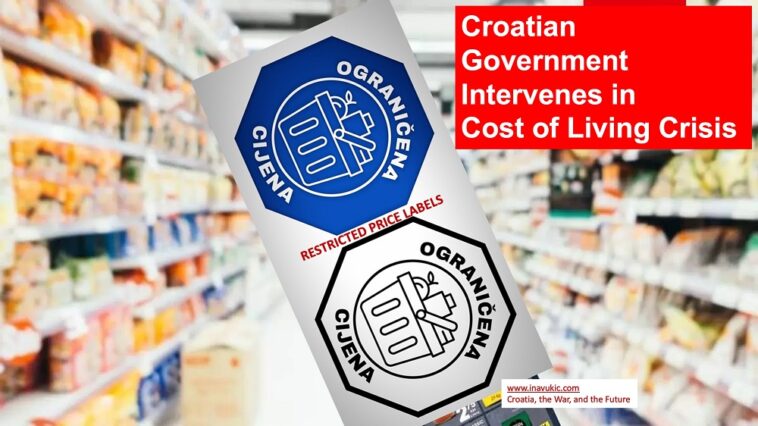With concerning level of inflation hovering around 12% in Croatia during the first quarter of 2023 and in August around 7.8% government attempts to curb it further have been the main topic of Croatian newsworthiness during the past week. With the peak tourist season ending, when prices of goods and services saw a great deal of runaway increases, particularly in the coastal region of Croatia, and given that tourism is among the main industries Croatia depends on for revenue it is somewhat odd and concerning that the government had not stepped in to interfere in prices with a similar force and determination before the tourist season began, i.e., when inflation was much higher. If one were to rely on media reports in Croatia this summer, then it is blatantly clear that high prices will most likely deter many tourists from returning to Croatia for holidays in 2024.
Cost of living crisis has been growing faster than before for more than eighteen months in Croatia with energy prices skyrocketing (as elsewhere in the world) during the post-Covid pandemic global energy crisis, 2021 – 2023, food prices as well, and especially just prior and post the adoption of euro as official currency at the beginning of 2023. But wages and pensions failed to follow suit and domestic food production saw a serious slump due to floods, other inclement weather events and pig diseases etc. Certainly. the supply of food was significantly lower than the demand, regardless of whether it was produced domestically or imported.
Governments will usually impose price ceilings when they believe that the equilibrium price in the market is too high and undesirable (e.g., weak consumers cannot afford a necessity, etc.). Good examples of markets where maximum prices could be imposed are food and housing. Food is a necessity and in countries such as Croatia where masses are on low incomes, many people might be unable to afford the quantities required for survival. Hence, governments could impose price ceilings on certain foods.
Last week in Croatian politics has seen the government capping the prices of a limited array of common products, as well as the introduction of the fifth package of economic measures aimed at alleviating the inflationary pressures felt by both the general public and business entities.
As from Monday 18 September 2023 the price freeze for the basic 30 products starts and will be returned to the level before January 1 of this year. All products whose prices will be limited will be marked with a special logo, a new label “Restricted Price“(Ograničena cijena). The decision to freeze prices for about 30 products in such a way was presented as part of a new package of economic measures devised by those in Croatian government and primarily aimed at aiding both individuals and business entities going forward. The package was voted in unanimously by the government.
“According to an already very good and established procedure, we consulted with partners, trade unions, employers, chambers of commerce and trade, pensioners, associations of cities and counties, representatives of the largest banks and retail chains in Croatia. This package is the result of government consultations with many actors “, Prime Minister Andrej Plenkovic said and then commented on the announced price freeze.
“The price freeze will guarantee more favourable prices for certain foodstuffs and will have the effect of slowing down inflation,” said the Prime Minister. “This package primarily aims to maintain a low price of electricity for all citizens, institutions, and businesses. It is a message of economic stability,” Plenkovic said, adding that the package contains measures for both pensioners and families.
“During talks with the government, the retail chains decided to make certain products cheaper, and I am sure that some of them will return some prices to the levels from the end of last year. I expect cooperation from them,” he said, adding that they had agreed with the banks that they would increase interest on deposits.
The price of electricity for households remains the same, but the semi-annual threshold is raised from 2,500 to 3,000 kWh. The price of electricity for the public sector and small businesses remains the same as well. There is no measure for large businesses; that is, electricity supply is to be contracted according to market conditions.
There appears to be a consensus in Croatia, particularly from pensioner umbrella organisations. that the price freeze is welcome, however, they are adamant that freezing prices of only 30 products does not go very far to alleviate living standard crisis especially since many essential products remain at old prices and insist that a much larger number of products would need to be included to make a meaningful mark for those on low incomes.(HRT TV Dnevnik news bulletin 15 September 2023)
Inflation is near a historical high since 1991 independence status of Croatia (during 1980’s inflation in former Yugoslavia exceeded 1000%). Central banks around the world have for a few years now been promising to intervene. However, a critical factor that is driving up prices remains largely overlooked: an explosion in profits. During the last decade, profit margins around the Western nations especially post-pandemic have reached levels not seen before and a number of corporate businesses in Croatia have not been lagging far behind. Bottlenecks in supply and demand chain caused by the Covid pandemic call for rather sudden or fast restructuring of production and I hope producers of food in Croatia will reap the benefits of this situation and not be restricted by EU quotas. Large corporations with market power have used supply problems as an opportunity to increase prices and scoop windfall profits. It would seem obvious that what is needed is a serious conversation about strategic price controls – just like it was after the Second World War. Croatia’s government has last week made a step in that direction, however small.
It is a known fact that leading world economists are divided into two opposing thoughts on the inflation question: one thought promotes the idea that we ought not to worry about inflation since it will soon go away while the other urges for fiscal restraint and a raise in interest rates. But a third option is sticking its neck out: the government could target the specific prices that drive inflation instead of moving to austerity which risks a recession.
“To use a metaphor: if your house is on fire, you would not want to wait until the fire eventually dies out. Neither do you wish to destroy the house by flooding it. A skilful firefighter extinguishes the fire where it is burning to prevent contagion and save the house. History teaches us that such a targeted approach is also possible for price increases.”
All said, price fixing (and wage fixing) can be harmful at any time and under any conditions because it spells out a large step toward a dictated, regimented, and authoritarian economy. Aside from prices, in reality, the main culprit of inflation is in increases in the supply of money and credit. Without a doubt, this is always brought on, directly or indirectly, by governmental policy—especially by governmental deficits which lead to an increase in the supply of money and credit. Croatia’s economy has not been the one to boast of sound operations and directions and people appear to have been living in a constant economic crisis for the past two decades at least. The current HDZ government bears large responsibility for the crisis and, hence, if not directly then indirectly or through “back room dealings” bears responsibility for price increases. Budget deficits and rising foreign debt had become a second skin to Croatia’s national operations, and funds from the European Union have plugged some holes since 2013, but not enough. The new package of economic measures announced by the Croatian government last week for the next six months is worth 464 million euros, in addition to the existing 551 million euros, which is the total value of the measures from the previous package that are in force for one year. The package includes various subsidies to business and additional payments to pensioners on low income, child support payment increases etc. How much of this package will be effective in reducing the supply-demand gap that drives the prices and how much will contribute to budget deficit and national debt is yet to be seen. Certainly, efforts to curb inflation are praiseworthy, but only if they produce positive results for the people truly struggling with the cost of life crisis every day. Ina Vukic




